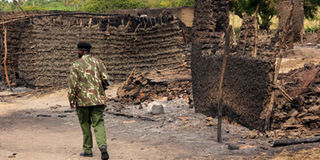Report traces police bullets to raiders

PHOTO | FILE Police officers patrol Kau Village in Tana River following an attack by bandits last year.
What you need to know:
- A report published last month by Conflict Armament Research claims that armed militias in northern Kenya and adjacent parts of neighbouring countries are using ammunition imported from Iran for Kenyan security forces
- These assertions could prove particularly embarrassing to the government because of the leading role it has played at the UN in efforts to establish a global treaty regulating transfer of small arms
- The Geneva-based Small Arms Survey concluded in 2008 that the Kenya Police and Police Reserve were the source of thousands of small-calibre cartridges used by several armed militia groups in the border triangle of Kenya, Uganda and South Sudan
Police are investigating a report that claims armed bandits and cattle-rustlers in Turkana, Samburu and other parts of northern Kenya may be using ammunition initially imported for use by government security forces.
The Kenya Police recently lost more than 40 officers in a botched operation against cattle-rustlers in the Suguta Valley.
A report published last month by Conflict Armament Research claims that armed militias in northern Kenya and adjacent parts of neighbouring countries are using ammunition imported from Iran for Kenyan security forces.
“Kenyan security forces are the confirmed source of Iranian ammunition that is in widespread circulation in the border regions of Kenya, South Sudan and Uganda,” the report states.
Contacted by the Nation on Sunday, Inspector-general David Kimaiyo confirmed the government had received the report and had launched investigations.
“We will study the report further and investigate all the claims,” Mr Kimaiyo said.
Government spokesman Muthui Kariuki said even though he was not aware of the imports, he would consult with the relevant authorities and respond on Monday.
These assertions could prove particularly embarrassing to the government because of the leading role it has played at the UN in efforts to establish a global treaty regulating transfer of small arms.
Ammunition fired from small arms in Africa is “a basic ingredient of organised violence, and is involved each year and at each war in uncountable deaths and crimes,” the New York Times noted on Saturday in a front-page story on the new report.
Ammunition produced in Iran, but marked in ways intended to prevent tracing, has also been imported by the governments of Côte d’Ivoire, Guinea and Sudan, the researchers say.
They further identify Iran as the source of ammo circulating illicitly in five other African countries.
Conflict Armament Research is a private UK-based company that tracks the origin of arms in conflict zones on behalf of governments and international organisations. It says its study is the product of six years of field research.
Four of the five investigators who worked on the report had previously held senior arms and conflict monitoring positions at the UN.
The Geneva-based Small Arms Survey concluded in 2008 that the Kenya Police and Police Reserve were the source of thousands of small-calibre cartridges used by several armed militia groups in the border triangle of Kenya, Uganda and South Sudan.
Evidence for this finding included first-hand observation of police supplying this type of ammunition to Turkana civilians in 2007 and 2008, the Conflict Armament Research study notes.
Requests for clarification made to the government at the time of the initial investigation and as recently as last November “remain unanswered,” the researchers say.
The researchers suggest that the government may have acquired the Iran-made ammunition between 2003 and 2006.
“This conclusion is arguably lent greater weight by the fact that UN Security Council prohibited the export of Iranian military material in March 2007, which should have deterred direct Kenyan ammunition acquisition from Iran after that date,” the report states.
Iran itself is not conclusively identified in the report as the direct source of the ammunition now in wide use in Africa. The researchers “are not sure if the ammunition had been directly sold by the Iranian government or its security services, by a government-or military-controlled firm, or by front companies abroad,” the New York Times noted.



